Rain comes with the territory when it comes to training and racing days. Unless it comes with lighting and thunder, extreme high winds or hail – it’s just another day and doesn’t have to keep you inside. The ultimate benefit of dealing with a rain day…it builds confidence in your ability to handle a rainy race day!
Here are a few tips for sticking with your training – or heading into a race day that looks like a soaker.
Open Water Swimming
You’re going to be wet anyway, so what’s the difference? There are a few things to keep in mind. Most important – if there is any thunder or lighting – WAIT at least 30 minutes after the last roll of thunder has subsided. Safety first.
Putting on a wetsuit when already wet can actually be easier, but keeping sand and grit out will be important. Try to stand on a towel and have a water bottle handy to rinse off feet before getting grit inside the wetsuit. Same for post-swim before putting on bike or running shoes.
Keeping goggles from fogging up might be more challenging. One quick fix is to use good old spit rubbed on the inside. Before getting wet, check that the straps for your goggles are in place – wet straps can get slippery and challenging to fix.
Remember to apply any anti-chafing products on your neck, wrists and ankles before getting wet.
Cycling
Starting out dry on a training day and encountering rain poses different challenges than starting out in a rain. Unless you’ve planned for rain, you get what you get in terms of your set up. Just be aware that roads will be extra slippery when rain is just getting started because of the residue from tires and oil. Any painted lines or metal inserts on the road will become very slippery – so extra care with speed and turns is in order. Safe riding on sunny days includes having a front and back light for visibility – and becomes even more important in rain.

Planning ahead for a rainy training day or race might include accounting for a change in temperature, especially if it becomes windy. You might pack arm warmers or a vest for warmth when you become wet. There are many lightweight options available that compact small enough to fit into a jersey pocket or into a flat pack. Or try fitting it into a ziplock bag and ziptie it to your bike under the top tube.
A light weight buff can come in handy for many reasons – neck warmth, keeping long soaked hair off your face, wiping down sunglasses or visors, or keeping wind out of ears. Carry it along with your phone, ID, cards/money in a ziplock bag for protection until it’s needed.
Keep in mind that everything becomes slippery and will swell when wet – so keep an extra grip on water bottles, loosen off your shoe straps when your socks become soaked to prevent numb feet from lack of circulation. Your chamois may become droopy when soaked causing your shorts to catch on the nose of your seat when in and out of the saddle.
A change of clothes for post-ride on training days is a smart move to prevent getting chilled from being wet – try to change quickly after finishing. This includes socks and run bra – two things that can become incredibly uncomfortable and chilling if left on when soaked.
Don’t forget to clean and lube your bike thoroughly after a rainy ride – the amount of dirt and sand in the drive train and in the components can cause bigger problems if left.
Transition
Race days that are soakers can be extra miserable. Returning to T2 and finding your running shoes floating is disheartening. All triathletes will have obsessed over the weather forecast and will have had the opportunity to plan in advance for mitigating some of the misery of a rainy day. But a few decisions must be made.
How much time are you willing to give up to be more comfortable on the bike or run by changing into dry socks or washing/drying/lubing your feet before getting on the bike or out on the run? How much will blisters slow you down if you choose not to take that time?
Either way – having a bottle of water at transition to rinse off your feet helps to avoid grit inside socks or shoes.

Running
Running in rain can be a freeing experience – it brings out the kid in you to splash through the puddles. On race day – its a different story. The question becomes, what to wear that will give you the best edge given the conditions?
Shoes – Your regular training shoes can feel very different when soaked. They can become heavy, the laces may tighten up as your socks and feet swell, and the upper might become sloppy. Those carbon plate race shoes may perform differently on wet pavement, especially if the course has tight turns to navigate. Hopefully you will have trained in wet conditions before race day to know what those shoes feel like so you can make the best decision.
Jacket or not? The question of what to wear adds a further dimension to the formula of dressing for temperatures 10 degrees higher than in the forecast. Wearing a rain jacket in an attempt to keep yourself dry can result in making you overheat quickly. A wind shell when soaked just clings to your body and will no longer break the wind. Sometimes the best option for retaining some warmth when on a soaking wet run might be a long sleeve technical shirt that offers a layer that your own body temperature will warm the inner layer as insulation. A wind vest can protect your core but allow for ventilation.
Hat – Probably a good choice so the peak can prevent rain from getting in your eyes. Wet hair can be held back off your face – and there is a layer of insulation to keep your head from losing heat if it becomes cooler.
Pre-Race – Still one of the most effective options is an oversized plastic garbage bag that can be easily ripped off once the race starts and your body warms up.
Socks – Your favourite socks might not be your favourite after being soaked. Some padded versions swell so your shoes feel tighter. Thinner socks can feel abrasive or slippery inside shoes when wet. Cotton will be horrible. Wool can be a good option, especially if your feet tend to feeling chilled. Whatever you choose – change out of wet socks quickly afterwards to help get warmed up.
Shorts & Tops – For some reason, soaking wet sport fabrics can feel more abrasive. Give more thought to using anti-chafing products around necklines, arms, nipples, waistbands before dressing.
Those shorts with pockets for your phone can become floppy and annoying, and looser versions of shorts can ride up inside your thighs causing chafing. A tighter fitting short – like a cycling short – might be a more comfortable choice.
Long tights or running pants could become heavy and droopy when soaked – choose these only if the temperatures are quite cool and your run is fairly long.
A final word about hydration and nutrition
It can be easy to overlook hydration and nutrition on a rainy day – but it still factors into your performance and recovery. In fact, your body might need more calories to balance out the effect of trying to maintain a core temperature. Shivering is an indicator that your body is working harder to stay warm. As always, nutrition is an important component of your training for any weather and can be fine tuned working with a nutritionist. Read more in our blog post here.



